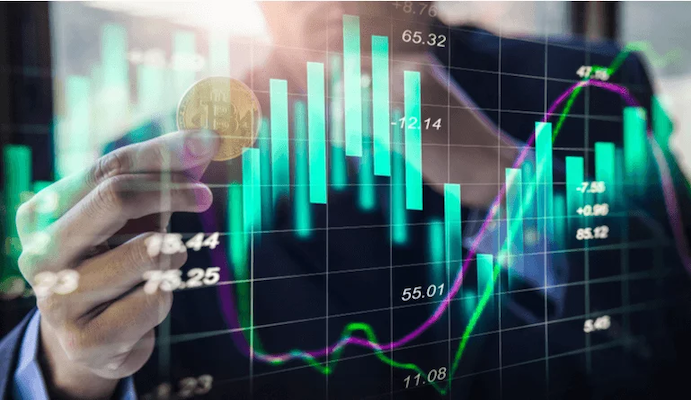Join Our Telegram channel to stay up to date on breaking news coverage
According to conventional thinking, assets like cryptocurrencies decrease in value as the dollar strengthens. However, is that actually the case?
The Federal Reserve increased the fed funds rate by 75 basis points for the third consecutive week this past week, as most experts had projected. Raising borrowing charges is intended to make money a little bit more expensive and thereby cool the hot economy because consumer prices have been rising at a rate not seen since the fourth season of Diff’rent Strokes for several months.
In words that crypto enthusiasts may comprehend, remember how everyone was buying UST because of the nearly 20% APYs the Anchor protocol was paying back in April? Higher interest rates increase demand for dollars. After increasing by approximately 20% in the previous year, the U.S. Dollar Index, which compares the dollar to a basket of six foreign currencies, is currently trading at a 20-year high. Bitcoin’s (BTC) price has fallen a staggering 58% over that time.
On Friday’s “First Mover” episode of CoinDesk TV, Mark Conners, head of research at 3IQ, said: “Dollar strength is a unilateral and forceful force.” The phrase “tsunami” is frequently used, but it truly, accurately describes what occurs during a period of strong dollar. Simply said, it drives away other assets from currencies.
However, it’s important to note that one shouldn’t extrapolate this. After all, compared to other asset classes, cryptocurrencies are still in their infancy. It has its own quirks, and prices fluctuate for reasons other than, example, the strength of the dollar.
For instance, in November 2021, bitcoin reached its all-time high, trading at around $69,000, more than quadrupling its value from the year before. The dollar index increased from around 92.7 to 95 during that time. Furthermore, the market’s perception of risk frequently appears to be reflected in price movement. The risk factor for cryptocurrencies is still very high. Having said that, cryptocurrency has been acting like some traditional assets lately, especially.
Equity markets suffered after the Consumer Price Index (CPI) for August was issued by the Bureau of Labor Statistics on September 13 and revealed a rise of 8.3% over the previous year (30 basis points higher than anticipated). For instance, the S&P 500 fell 6.2% in the week that followed the announcement.
Crypto market trends
But when we look at individual industries, some did better than others. For instance, financials fell 5%. (banks like higher interest rates in the long-term because they ultimately benefit their balance sheets). On the other hand, real estate stocks had a 9.8% decline as higher rates make it more difficult to leverage with mortgages and raise cap rates for commercial buildings.
In the week that followed the release of the CPI data, cryptocurrencies performed significantly worse than stocks overall. During those seven days, the CoinDesk Market Index (CMI), a cap-weighted index of 148 of the biggest cryptocurrencies, fell 13.5%. We see variations based on sector in this area as well. The value of the CoinDesk Smart Contract Platform Index (SMT), which includes cryptocurrencies like ether (ETH), ADA by Cardano, and SOL by Solana, fell by 19.8%.
While other assets in the index also decreased as a result of the sell-off, a sizeable percentage of the decline was undoubtedly attributable to ether’s post-Merge collapse rather than just the general state of the market. While this was going on, the CoinDesk Culture & Entertainment Index (CNE), which contains many NFT-related and metaverse coins, including ApeCoin’s APE, Decentraland’s MANA, and The Sandbox’s SAND, declined by “only” 6.9%, outperforming four equities sectors.
Jodie Gunzberg, managing director of CoinDesk Indices, said on Thursday’s “First Mover” episode that “high inflation, rising rates, and a strong dollar, yes, it puts downward pressure on all of the digital assets, but it’s not equal.” Because they “are not as economically sensitive as something like DeFi or the currencies or the smart contract platforms that are just much more closely related to the financial markets,” the cryptocurrencies in the CoinDesk Culture & Entertainment Index didn’t suffer as much as other cryptocurrencies.
According to Gunzberg, this action follows a well-known pattern seen in stocks. She remarked, “That’s not much different from the defensive sectors we see again in the S&P 500.” “There are more defensive features in activities like leisure, amusement, and gaming. Then there are others in some of the more delicate industries, like real estate.”
When traders think of cryptocurrencies in terms of sectors, they can develop more complex trading strategies for environments with rising rates, among other things.
You can develop long-term strategies, short-term strategies, or strategies that favor certain industries, such as culture and entertainment or the digitalization market. The smart contract platforms, which are severely suffering in the current economic climate, can then be underweighted.
The market is currently preparing for yet another rate increase in November of 75 basis points. As of Friday afternoon, traders are assigning a 71.7% probability that the U.S. central bank would increase rates by three-quarters of a percent to a range of 3.75% to 4%, according to the CME’s FedWatch Tool. As they say, it depends on the data, and a lot could happen in the following month or so.
Prospects of P2E gaming sector
Nowadays, enthusiasts of cryptocurrencies have a new alternative for high growth in the form of the Tamadoge ecosystem. The idea is similar to Tamagotchi in that users can buy a pet, feed it, and then engage in combat with it once it has grown up. Because it is a play-to-earn (P2E) platform, players may make money while having fun and moving up the leaderboard by gaining Doge points. TAMA is a meme coin with utility that will be used to discover all of the special features of the platform.
Apart from that, there is a lot to anticipate with the release of the augmented reality software (AR app) in the fourth quarter of 2023. The ability to be close to their pets while using the app will make it much easier for players to commit to maintaining their well-being.
As a result, a great deal of people are turning to TAMA for investments because of the excitement it has generated as a result of the current level of success it is enjoying. In a few weeks, Tamadoge raised more than $19 million, which is unquestionably a success that all investors want to be a part of.
Tamadoge will have its initial coin offering (IDO) on OKX. TAMA is set to list at $0.03 on Sept 27th.”
Investors should do their own research and and consider all factors before making a decision with potentially high reward. The full paper and roadmap for TAMA can be read here.
Related
Join Our Telegram channel to stay up to date on breaking news coverage


